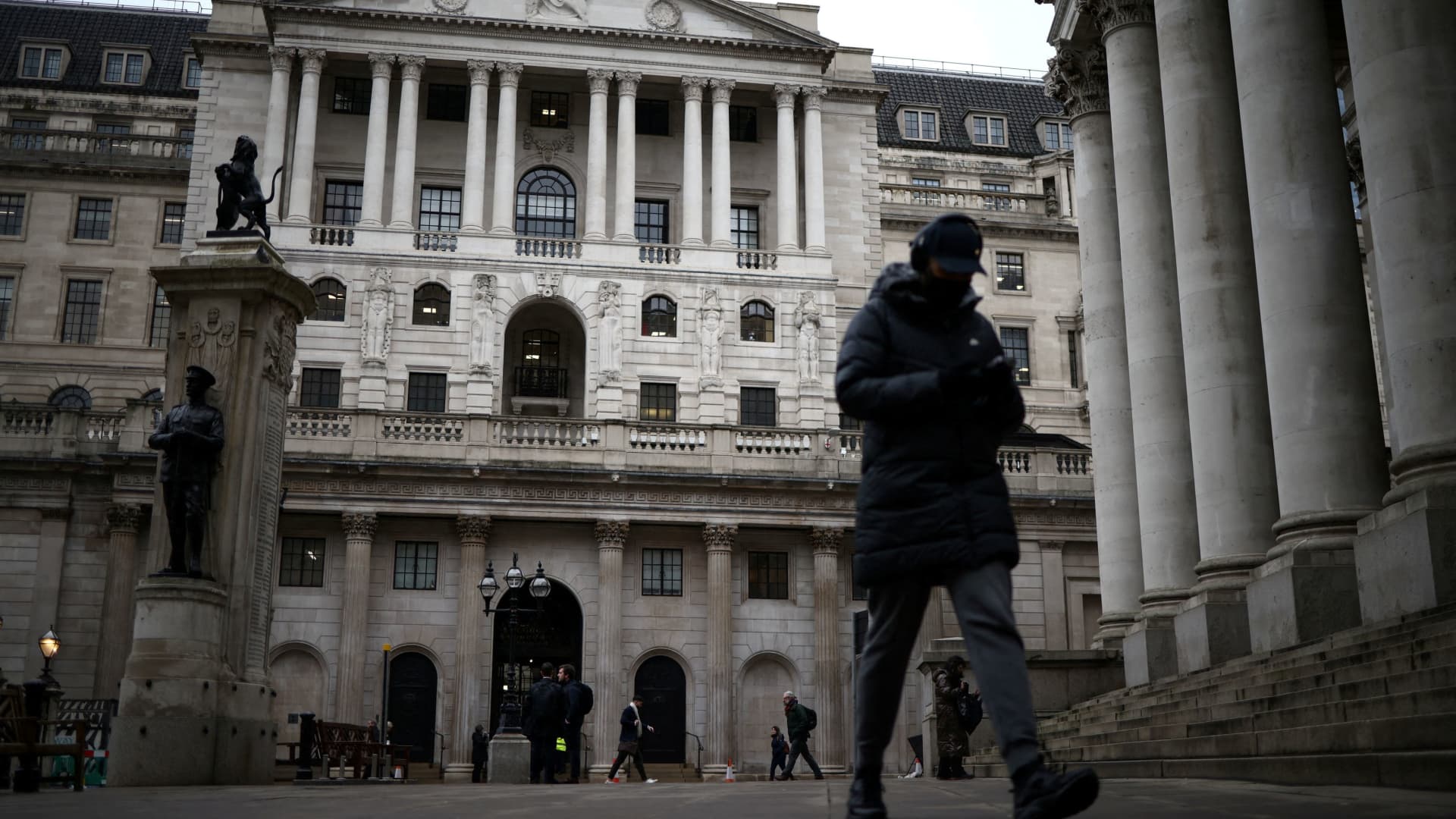People walk outside the Bank of England in the City of London financial district, in London, Britain, January 26, 2023.
Henry Nicholls | Reuters
LONDON — The Bank of England is widely expected to keep interest rates unchanged on Thursday, as data continues to show moderating price pressures and weakening economic activity.
As of Thursday morning in London, the market was pricing around an 89% probability of a second consecutive hold, after the Bank ended a run of 14 straight hikes in September with a surprise 5-4 vote among members of the Monetary Policy Committee.
U.K. inflation came in at 6.7% in September, unchanged from the previous month and considerably higher than in other G7 economies. Britain’s inflation remains on a general downward trajectory.
Meanwhile, recent PMI data points to a soft economic growth outlook, while the labor market, a key indicator for the MPC, has shown signs of loosening.
The S&P Global/CIPS flash PMI (purchasing managers’ index) reading for October reflected that business activity decreased for the third straight month in October and posted its largest monthly decline since January, recording lower output in both the manufacturing and services sectors.
New work and backlogs of work declined, suggesting a lack of pressure on business capacity, while private sector employment fell for the second month in a row and lower confidence in the year-ahead business outlook resulted in hiring freezes. Business optimism sank to its lowest point in 2023, the S&P Global report said.
“U.K. economic activity appears to have slowed further, the housing market is weaker, consumer spending is falling, and inflationary pressure is showing further signs of dissipating. It’s only wage growth that has surprised to the upside, but this is unlikely to persist given other indicators of labour market weakness,” said Mike Riddell, head of macro unconstrained at Allianz Global Investors, on Tuesday via email.
The firm agrees with market consensus that rates will stay on hold.
“No doubt the BoE will signal that rates can still rise if economic data indicates a need, but as voting member Swati Dhingra recently highlighted, the long lags between changes in monetary policy and their impact on the economy mean that only up to a quarter of all the BoE hikes in this cycle have made a dent on the UK economy so far,” Riddell said.
He added that the MPC will be keen to keep its options open but will for now want to wait and observe how much pain prior hikes inflict on the economy.
In a research note on Tuesday, Barclays another rate hold is all but guaranteed, given a softer-than-expected data flow compared to the MPC’s last set of projections in August, along with the surprise pause in September, when the economy was “if anything, slightly less weak than now.”
The British lender sees the U.K. central bank rate remaining at 5.25% until August 2024, before the first of an expected four 25 basis point cuts.
“We expect that the data-dependent guidance is unlikely to change, with the MPC preserving, at least in theory, the possibility of further hikes in order to prevent expectations of cuts being brought further forward,” said Barclays economist Abbas Khan.
“In terms of the vote split, we expect a 1-6-2 outcome (-25bp/hold/+25bp respectively), with external member Dhingra voting for a cut (which would be the first time a committee member has voted to lower rates in this hiking cycle), and with external members Haskel and Mann voting for a 25bp hike.”
Markets not expecting rates below 4% ‘ever again’
While the MPC’s Dhingra noted the need to assess the lagging impact of monetary tightening, fellow member Catherine Mann said that she was still concerned about persistent rises in the cost of living in the U.K. With annual CPI unchanged in the last print, there could be no guarantees that the Bank has finished hiking.
Central banks will now be wary of fresh upside risks to energy prices and supply chains, if the Israel-Hamas conflict envelopes the wider region.
Markets are not pricing any further hikes, but Allianz’s Riddell highlighted that only a few further gradual cuts are expected from August 2024 over the subsequent few years and said it was “striking that the market’s central case is for the BoE to not cut interest rates below 4% ever again.”
“The only way that we can rationalise this is if U.K. inflation remains stuck at 3% or higher forever, and/or the U.K. economy avoids a meaningful recession,” he said.
“But the spare capacity that is set to be created following the very aggressive rates hikes of the last year leads us to conclude that the hit to U.K. growth is likely to be far greater than markets are currently discounting, and inflation pressure ought to therefore quickly subside through this year and especially into next year.”
Central banks around the world are reaching a pivotal stage, as they near the end of lengthy monetary tightening cycles, following significant progress in wrestling down sky-high inflation.
The U.S. Federal Reserve will announce its latest monetary policy decision on Wednesday and is also expected to leave rates on hold in light of recent economic data and a spike in U.S. Treasury yields.
The European Central Bank last week held rates steady at their current record high of 4%, ending a run of 10 straight hikes.
